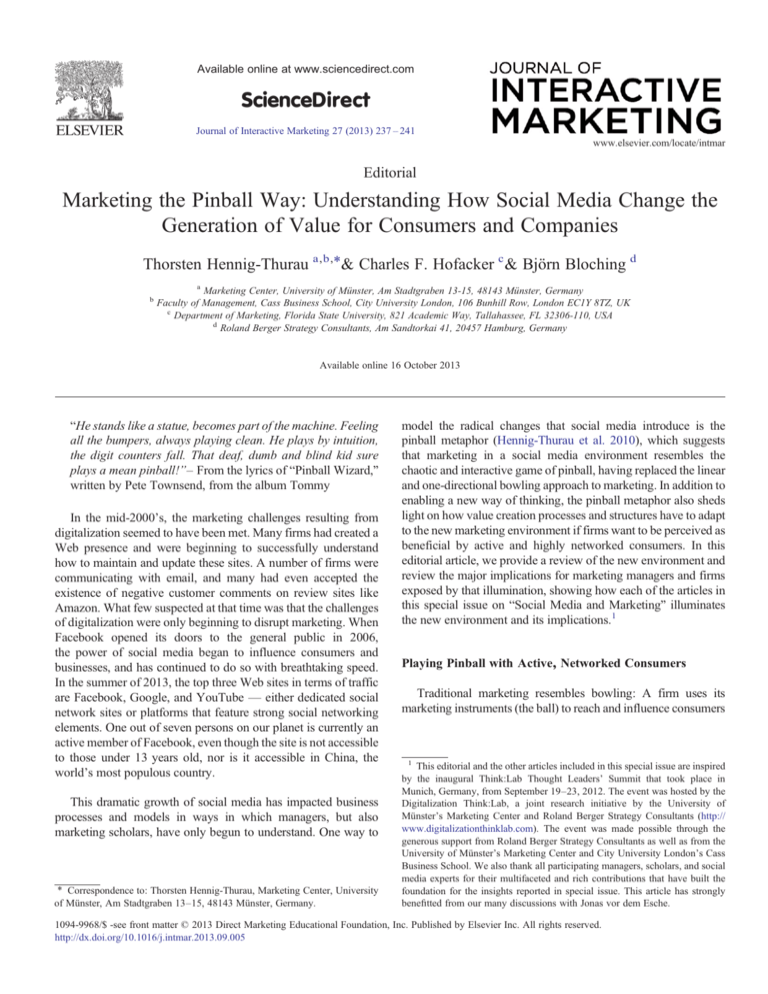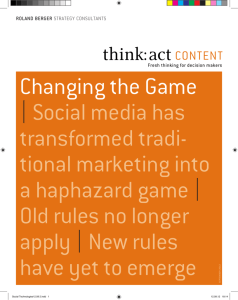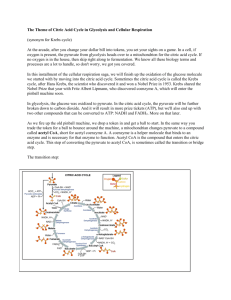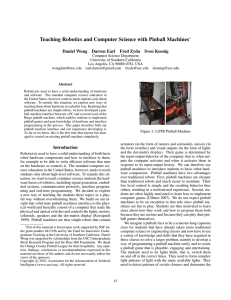
Available online at www.sciencedirect.com
ScienceDirect
Journal of Interactive Marketing 27 (2013) 237 – 241
www.elsevier.com/locate/intmar
Editorial
Marketing the Pinball Way: Understanding How Social Media Change the
Generation of Value for Consumers and Companies
Thorsten Hennig-Thurau a,b,⁎& Charles F. Hofacker c & Björn Bloching d
a
b
Marketing Center, University of Münster, Am Stadtgraben 13-15, 48143 Münster, Germany
Faculty of Management, Cass Business School, City University London, 106 Bunhill Row, London EC1Y 8TZ, UK
c
Department of Marketing, Florida State University, 821 Academic Way, Tallahassee, FL 32306-110, USA
d
Roland Berger Strategy Consultants, Am Sandtorkai 41, 20457 Hamburg, Germany
Available online 16 October 2013
“He stands like a statue, becomes part of the machine. Feeling
all the bumpers, always playing clean. He plays by intuition,
the digit counters fall. That deaf, dumb and blind kid sure
plays a mean pinball!”– From the lyrics of “Pinball Wizard,”
written by Pete Townsend, from the album Tommy
In the mid-2000's, the marketing challenges resulting from
digitalization seemed to have been met. Many firms had created a
Web presence and were beginning to successfully understand
how to maintain and update these sites. A number of firms were
communicating with email, and many had even accepted the
existence of negative customer comments on review sites like
Amazon. What few suspected at that time was that the challenges
of digitalization were only beginning to disrupt marketing. When
Facebook opened its doors to the general public in 2006,
the power of social media began to influence consumers and
businesses, and has continued to do so with breathtaking speed.
In the summer of 2013, the top three Web sites in terms of traffic
are Facebook, Google, and YouTube — either dedicated social
network sites or platforms that feature strong social networking
elements. One out of seven persons on our planet is currently an
active member of Facebook, even though the site is not accessible
to those under 13 years old, nor is it accessible in China, the
world's most populous country.
This dramatic growth of social media has impacted business
processes and models in ways in which managers, but also
marketing scholars, have only begun to understand. One way to
⁎ Correspondence to: Thorsten Hennig-Thurau, Marketing Center, University
of Münster, Am Stadtgraben 13–15, 48143 Münster, Germany.
model the radical changes that social media introduce is the
pinball metaphor (Hennig-Thurau et al. 2010), which suggests
that marketing in a social media environment resembles the
chaotic and interactive game of pinball, having replaced the linear
and one-directional bowling approach to marketing. In addition to
enabling a new way of thinking, the pinball metaphor also sheds
light on how value creation processes and structures have to adapt
to the new marketing environment if firms want to be perceived as
beneficial by active and highly networked consumers. In this
editorial article, we provide a review of the new environment and
review the major implications for marketing managers and firms
exposed by that illumination, showing how each of the articles in
this special issue on “Social Media and Marketing” illuminates
the new environment and its implications.1
Playing Pinball with Active, Networked Consumers
Traditional marketing resembles bowling: A firm uses its
marketing instruments (the ball) to reach and influence consumers
1
This editorial and the other articles included in this special issue are inspired
by the inaugural Think:Lab Thought Leaders' Summit that took place in
Munich, Germany, from September 19–23, 2012. The event was hosted by the
Digitalization Think:Lab, a joint research initiative by the University of
Münster's Marketing Center and Roland Berger Strategy Consultants (http://
www.digitalizationthinklab.com). The event was made possible through the
generous support from Roland Berger Strategy Consultants as well as from the
University of Münster's Marketing Center and City University London's Cass
Business School. We also thank all participating managers, scholars, and social
media experts for their multifaceted and rich contributions that have built the
foundation for the insights reported in special issue. This article has strongly
benefitted from our many discussions with Jonas vor dem Esche.
1094-9968/$ -see front matter © 2013 Direct Marketing Educational Foundation, Inc. Published by Elsevier Inc. All rights reserved.
http://dx.doi.org/10.1016/j.intmar.2013.09.005
238
Editorial
(the pins). Mass media (the bowling alley) function as mediators
for marketing content; these media have to be carefully attended
to because they can also influence the effectiveness of marketing
actions. Social media change the picture — marketing is now
better characterized as a pinball game (Hennig-Thurau et al.
2010). The pinball machine comprises the environment in which,
as in the bowling metaphor, marketing instruments (the balls) are
used to reach consumers (the various targets of the machine —
bumpers, kickers, and slingshots).
There are two major differences that reflect the changes in
consumer behavior that have been associated with the rise of
social media: Increased active participation and a strong level of
networked interconnectedness. As a result, consumers in the new
pinball environment have much more power than they had in
the old bowling environment, which shapes their behavior in
the market place. Labrecque et al. (2013–this issue) offer an
in-depth investigation of the evolution of this power and its
impact on consumer behavior. Those empowered consumers not
only receive messages like bowling pins, they actively participate
via social media by sharing brand and product experiences with
friends via status updates or even filmed reviews. Such consumer
actions are immediate and often visible by large numbers of other
consumers; they can change the intensity and even meaning of
the original message in numerous possible ways. As a result, the
ball is diverted, accelerated or slowed, and sometimes brought to
a complete halt. Labrecque et al. (2013–this issue) introduce the
concept of community-based power and argue that consumers
can even seize the initiative in the game. Mass media in the form
of slingshots and bumpers further increase the unpredictability of
the game, multiplying social media episodes and providing the
basis for future pinball activity.
How Pinball Affects Value Creation: Brands, Customer
Relationships, and Selling
Most, if not all, of the mechanisms by which marketing creates
value for consumers and companies are substantially affected by
the spread of social media and the ensuing pinball effect. In the
following, we illustrate how the mechanisms change for three key
marketing assets– namely brands, customer relationships, and
selling– and discuss some potential consequences.
Brand Management in the Pinball Age
One of the broadest implications of the pinball metaphor is
that companies have, at least partially, lost control of marketing
activities. Nowhere is the loss of control more critical than in the
area of branding, where the firm strives to manage consumer
reactions to brand-related pinballs in a way that is consistent with
its goals. Gensler et al. (2013–this issue) suggest that the key for
these firms will be to accept that the game has changed and to
therefore co-create brand stories with active consumers, instead
of continuing to do so autonomously. Gensler et al. (2013–this
issue) point out that brand stories are essential in determining the
meaning of brands, and they offer a powerful framework for how
such stories are developed in the new pinball environment.
Among those requirements that are central for successful branding
in the social media era are monitoring the pinball machine and
effective moderation of the brand story development process.
Monitoring the Machine. Given the cacophony of pinball
activities taking place, the monitoring of the plethora of multimedia content from consumers deserves particular attention
from companies (Gensler et al. 2013–this issue). The task does
not end with issuing a new brand-related pinball, but requires
following its course very closely. In addition to measuring
the volume of social communication, managers have to keep track
of the communication's content and sentiment, which enables
them to immediately identify trends and crises (e.g., Schweidel
and Moe 2012; see also Peters et al. 2013–this issue). Whereas the
dominant approach appears to be to use quantitative measures
involving artificial intelligence, a promising alternative might
be to apply netnography (Kozinets 2002) to understand changes
in brand sentiment and image.
Active Moderation. A second key challenge for brand
management in these pinball times is to change from solo
creators to cooperating moderators of the development of the
brand story (Gensler et al. 2013–this issue; Godes et al. 2005).
Such moderation is demanding, as it requires balancing the
stimulation of consumer brand engagement while steering that
engagement in a direction that is consistent with the company's
interests. Being overly restrictive can reduce engagement, while
too little restriction can result in an inconsistent and thus a
confusing brand story — the flippers must be handled deftly.
This cooperation is new territory for brand managers, and little
generalizable knowledge exists regarding the handling of the
moderation process. A powerful example of effective moderation
is Procter & Gamble's Old Spice campaign, which first managed
to create engagement through provocative videos for the
worn-out brand and then steered this engagement through a
“response campaign” in which 186 videos were filmed, each of
which a response to an individual fan's Twitter or Facebook
comment (Kalamut 2010).
Moderation is also critical when negative comments escalate
into a crisis that threatens the brand, the biggest threat associated
with social media by managers (IBM 2011). With millions of
consumers able to articulate negative experiences with and
attitudes about goods and services, such social media crises
occur all the time, but their extent and impact differ dramatically.
Few crises become as widely known as Singer Dave Carroll's
painful service experience with United Airlines, which he
summarized in the song “United Breaks Guitars” that pinballed
all the way to viral status. The business impact of such social
word-of-mouth is not yet well understood; the few existing
findings indicate that social word-of-mouth can impact diffusion
patterns (Thurau et al. 2013), product sales (Rui et al. 2013), and
companies' market value (Bollen et al. 2011). None of these
studies investigated crises in particular, so many unanswered
questions remain. Given their heterogeneous nature, companies
need to learn how to identify those bumpers and balls that have the
strongest threat potential.
Once a crisis develops, effective strategic reaction requires
an integration of brand management and individual customer
Editorial
management (see Gensler et al. 2013–this issue). Communication has a strong de-escalation potential, but can also inflate the
problem. When Nestlé was criticized by users for its use of palm
oil, the firm reacted by deleting critical posts, arguing “It's
our site, we set the rules.” Such an authoritarian communication
style ignored the co-creative, interactive nature of the pinball
environment and thus led to an escalation of the crisis rather than
solving it. Social media research might benefit from researchers
who have studied complaint management (like Stauss and Seidel
2004), although consumer voice in the pre-pinball age usually
lacked the public, chaotic character of the current environment.
Managing Customer Relationships in the Pinball Age
The pinball metaphor also implies substantial changes for the
management of customer relationships — if done successfully,
the key bumpers (i.e. social media opinion leaders) act in a way
that helps the company to achieve a high pinball score. Malthouse
et al. (2013–this issue) utilize the term “social CRM” to describe
managing customer relationships in the pinball environment,
introducing a social CRM house that combines foundational
elements of general management (namely, strategies, people,
information, and metrics) with combinations of engagement
and CRM processes.
Social media enable relationships to be managed on the level
of the individual consumer, something that is especially important but also challenging for firms that have not yet had
one-by-one relationships but have only managed anonymous
customer segments. Engaging consumers in such potentially
valuable interactions is not easy, as there is a large number of
brands and companies striving for consumers' limited time,
attention, and emotional resources. Thus companies need to learn
what kind of social CRM leads to consumer engagement.
Research suggests that interesting and arousing content helps
(Berger 2011; Berger and Milkman 2012) but this might be too
vague to be of managerial value.
One key characteristic of social media is its informal and
personal nature — consumers share their likes and loves with
others through networks and might expect something in return
from their befriended if not beloved brands. Celebrities like
Ashton Kutcher are successful because they share private
perspectives with their social media friends. What could be the
equivalent for CRM managers? Microsoft was successful when
they let Robert Scoble chat about company insights in a very
personal and sometimes critical way; as “Chief Humanizing
Officer” (The Economist 2005) Scoble helped the company to
be perceived more favorably by the public. Whereas social
communication is valuable when authentic, value offered by
CRM and social media managers (or agencies) is today often
confused with short-lived gimmickry.
Selling and Transactions in the Pinball Age
Firm revenue is directly driven by sales and the activities
surrounding transactions. How can the pinball machine be used
to influence sales transactions, in addition to building brands
and to managing long-term relationships? Yadav et al. (2013–this
239
issue) argue that the answer is tightly linked to the emerging
concept of social commerce. The authors define social commerce
as “exchange-related activities that occur in, or are influenced by,
an individual's social network in computer-mediated social
environments” and stress its different facets: marketing activities
designed to stimulate transactions and other activities intended to
influence consumers' purchase decisions, but which are directed
at other stages of the decision-making process.
Transaction-focused social commerce involves the direct use
of social networks in selling products. In other words, can the
pinball machine be transformed into a digital shopping center?
Attempts by firms to sell products via Facebook have been
mostly unsuccessful (e.g., Nordstrom, Warner Bros.), but
Yadav et al. (2013–this issue) suggest that these failures
might be the result of contextual factors rather than general
ineptness. Recent innovations by Facebook such as the “Gifts”
option indicate that a potential for success exists if
transaction-focused social commerce is done competently.
Information-focused social commerce includes the product
evaluation by the potential buyer's friends, as is implemented
by Amazon or the Google Play retail platform. Initial research
has shown that such social effects influence key success metrics
such as customer retention (Haenlein 2013; Nitzan and Libai
2011). Fully understanding the effect of information-focused
social commerce would benefit from isolating the effects of
social word-of-mouth from other kinds of word-of-mouth such
as standard, anonymous Amazon reviews. Yadav et al.
(2013–this issue) note that teasing apart social from other
word-of-mouth effects would be valuable, particularly if the
mobile component of social information is considered.
Pinball Requires New Methods and Measures
Keeping score in bowling is not the same as keeping score
in pinball! The changes to marketing strategy and actions in
the new pinball environment imply that we need to collect new
kinds of information to guide the firm's handling of the
pinball machine. The new information is needed to evaluate
marketing performance in a way that adequately captures the
elements of the new paradigm such as the interconnectedness
of customers and their active role in the marketplace. But what
are essential metrics or key performance indicators of pinball
marketing?
Peters et al. (2013–this issue) suggest that such metrics
are needed for four different facets of the pinball environment —
consumer engagement motives, the content generated by
consumers, the structure of the consumers' network, and
consumers' social roles and interactions. The authors derive
nine guidelines that companies should consider when choosing
their set of social media metrics.
In addition to adding new metrics to their dashboards,
companies should also consider redefining existing metrics on
the level of the individual consumer, such as customer lifetime
value (CLV) (Berger and Nasr 1998). Although some
traditional models of CLV and customer equity already include
some word-of-mouth elements (Hogan, Lemon, and Libai
2003), these metrics are not fully able to capture the viral
240
Editorial
dynamics that are inherent to the pinball environment.
Customer metrics have to better account for the influence
score of consumers (Nitzan and Libai 2011). In today's
networked economy, people who reach and actively influence
thousands or even millions of people through their status
updates or tweets might not buy a company's products at all,
but have a much stronger impact on the company's prospects
than some heavy shoppers. Metrics such as the Klout score
have been developed, but are generally used in isolation
instead of being integrated with customer metrics. As an
example, in March 2013, American Airlines opened up its
Admirals Club lounges to influential flyers, regardless of
whether they were customers of the airline (Hoang 2013).
Similarly, Kumar, Peterson, and Leone (2007, 2010) have
suggested customer referral value as a separate metric. The
ideal solution would be to integrate purchase-focused and
holistic influence-focused metrics, but such an integration
would require deep knowledge of the business impact of social
networks.
Pinball Affects Organizational Processes and Structures
Marketing can be practiced by a single individual, but is
mostly embedded within an array of organizational activities.
Thus, effective pinball must be understood as a team sport — an
insight that was boldly underlined by numerous social media
practitioners during the thought leadership conference that led
to this special issue. Consider a social media crisis whose
development is usually determined within its very first hours.
Social media managers need to be capable of identifying the
threat potential of a crisis, of responding whenever the crisis
breaks out, be authorized to offer competent and substantive
answers to sometimes fundamental problems, and have access
to a variety of resources. Can the marketing manager (or even
the CEO) be contacted if the crisis breaks out during a
weekend or vacation period? Inflexible routines do not allow
such reactions, which imply cross-functional communication,
and cultures often are built on the assumption that it is the
company who sets the agenda of activities, not the tweeting
customers.
Firms have not yet allocated substantial budgets for
learning how to play pinball (Owyang et al. 2011), nor has
academic research shed much light on the organizational
adaptations required for success in the new pinball environment. Two studies in this issue shed initial insight into this
far-reaching and complex matter. Weinberg et al. (2013–this
issue) focus on the concept of social business and offer
arguments why transforming organizations into such social
businesses is a promising move, stressing the powers that are set
free when firms substitute silo-type structures by more cross-silo
collaboration, and when employees are enabled to display
expressive individuality. They illustrate their ideas by referring
to Dell's transformation toward a social business, which included
the “social media accreditation” of a large number of employees
and the development and execution of new metrics. In
addition, Malthouse et al. (2013–this issue) also shed light on
the role of organizational elements for mastering the challenges
that social media bring for customer relationship management,
stressing the need of an empowered culture and skilled employees,
among other things. Those wide-ranging organizational implications of social media can guide firms which now outsource
their social media activities to agencies along their way to
becoming powerful pinball players.
Conclusion
As a result of the dramatic changes social media bring, the
marketing world needs to move from bowling to pinball. This
special issue addresses key implications of this necessary transition
including the rise of consumer power, the co-creation of brand
stories, the new social-CRM, the invention of social commerce, the
need for new metrics, and the necessary organizational adaptations
in a pinball world.
The implications of the paradigm shift from bowling to
pinball are far-reaching not only for marketing managers and
companies, but also for the marketing discipline itself. To keep
in touch with the marketplace, scholars in every area of the
marketing discipline need to understand the implications and
consequences of the new paradigm. Playing pinball ourselves
might be a good place to start.
References
Berger, Jonah (2011), “Arousal Increases Social Transmission of Information,”
Psychological Science, 22, 7, 891–3.
——— and Katherine L. Milkman (2012), “What Makes Online Content
Viral?,” Journal of Marketing Research, 49, 2, 192–205.
Berger, Paul D. and Nada I. Nasr (1998), “Customer Lifetime Value:
Marketing Models and Applications,” Journal of Interactive Marketing,
12, 1, 17–30.
Bollen, Johan, Huina Mao, and Xiaojun Zeng (2011), “Twitter Mood
Predicts the Stock Market,” Journal of Computational Science, 2, 1,
1–8.
Gensler, Sonja, Franziska Völckner, Yuping Liu-Thompkins, and Caroline
Wiertz (2013), “Managing Brands in the Social Media Environment,”
Journal of Interactive Marketing, 27, 4, 242–56 (this issue).
Godes, David, Dina Mayzlin, Yubo Chen, Sanjiv Das, Chrysanthos Dellarocas,
Bruce Pfeiffer, Barak Libai, Subrata Sen, Mengze Shi, and Peeter Verlegh
(2005), “The Firm's Management of Social Interactions,” Marketing
Letters, 16, 3–4, 415–28.
Haenlein, Michael (2013), “Social Interactions in Customer Churn Decisions:
The Impact of Relationship Directionality,” International Journal of
Research in Marketing, 30, 3, 236–48.
Hennig-Thurau, Thorsten, Edward C. Malthouse, Christian Friege, Sonja
Gensler, Lara Lobschat, Arvind Rangaswamy, and Bernd Skiera (2010),
“The Impact of New Media on Customer Relationships,” Journal of Service
Research, 13, 3, 311–30.
———, Carolyn Wiertz, and Fabian Feldhaus (2013), “Does Twitter Matter?
An Investigation of the Impact of Microblogging Word of Mouth on
Consumers' Adoption of New Product,” Manuscript available at http://
papers.ssrn.com/sol3/papers.cfm?abstract_id=2016548 2013.
Hoang, Don (2013), “American Airlines’ Admirals Club Welcomes Klout
Users in Nearly 40 Locations,” http://blog.klout.com/2013/05/americanairlines-klout/, accessed September 24, 2013.
Hogan, John E., Katherine N. Lemon, and Barak Libai (2003), “What Is the
True Value of a Lost Customer?,” Journal of Service Research, 5, 3,
196–208.
IBM (2011), From Stretched to Strengthened: Insights from the Global Chief
Marketing Officer Study. New York: CMO C-Suite Studies.
Editorial
Kalamut, A. (2010), Old Spice Video “Case Study”. http://www.youtube.com/
watch?v= Kg0booW1uOQ&feature=player_embedded#!, accessed January
2, 2012.
Kozinets, Robert V. (2002), “The Field Behind the Screen: Using Netnography
for Marketing Research in Online Communities,” Journal of Marketing
Research, 39, 1, 61–72.
Kumar, V., J. Andrew Petersen, and Robert P. Leone (2007), “How
Valuable Is Word–of–Mouth?,” Harvard Business Review, 85, 10,
139–44.
———, J. Andrew Petersen, and Robert P. Leone (2010), “Driving
Profitability by Encouraging Referrals: Who, When, and How,” Journal
of Marketing, 74, 5, 1–17.
Labrecque, Lauren Isabelle, Jonas vor dem Esche, Charla Mathwick,
Thomas P. Novak, and Charles F. Hofacker (2013), “Consumer Power:
Evolution in the Digital Age,” Journal of Interactive Marketing, 27, 4,
257–69 (this issue).
Malthouse, Edward C., Michael Haenlein, Bernd Skiera, Egbert Wege, and
Michael Zhang (2013), “Managing Customer Relationships in the Social
Media Era: Introducing the Social CRM House,” Journal of Interactive
Marketing, 27, 4, 270–80 (this issue).
Nitzan, Irit and Barak Libai (2011), “Social Effects on Customer Retention"
Journal of Marketing, 75, 6, November, 24–38.
Owyang, Jeremiah, Charlene Li, Christine Tran, and Andrew Jones (2011),
How Corporations Should Prioritize Social Business Budgets. San Mateo:
Altimeter Group.
241
Peters, Kay, Yubo Chen, Andreas M. Kaplan, Björn Ognibeni, and Koen Pauwels
(2013), “Social Media Metrics — A Framework and Guidelines for Managing
Social Media,” Journal of Interactive Marketing, 27, 4, 281–98 (this issue).
Rui, Huaxia, Yizao Liu, and Andrew Whinston (2013), “Whose and What
Chatter Matters? The Effect of Tweets on Movie Sales,” Decision Support
Systems, 55, 4, 863–70.
Schweidel, David A. and Wendy W. Moe (2012), “The Perils of ‘Selective
Listening’ in Social Media Monitoring: Sentiment and Venue Choice in
Social Media Posting Behavior,” Manuscript available at http://papers.ssrn.
com/sol3/papers.cfm?abstract_id=1874892.
The Economist (2005), “Chief Humanizing Officer – Does Robert Scoble, a
Celebrity Blogger on Microsoft’s Payroll, Herald the Death of Traditional
Public Relations?” Accessed January 13, 2012. http://www.economist.com/
node/ 3644293?story_id=3644293.
Stauss, Bernd and Wolfgang Seidel (2004), Complaint Management: The Heart
of CRM, Thompson/South-Western.
Weinberg, Bruce D., Ko de Ruyter, Chrysanthos Dellarocas, Michael Buck, and
Debbie I. Keeling (2013), “Destination Social Business: Exploring an
Organization's Journey with Social Media, Collaborative Community and
Expressive Individuality,” Journal of Interactive Marketing, 27, 4, 299–310
(this issue).
Yadav, Manjit, Kristine de Valck, Thorsten Hennig-Thurau, Donna L.
Hoffman, and Martin Spann (2013), “Social Commerce: A Contingency
Framework for Assessing Marketing Potential,” Journal of Interactive
Marketing, 27, 4, 311–23 (this issue).







![[Introduction] Video Games and Computer Holding Power](http://s3.studylib.net/store/data/007919935_1-0dced96c30b48e523ed891dd06bb768a-300x300.png)



